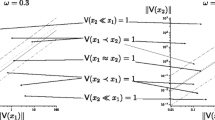Abstract
Many geographical applications deal with spatial objects that cannot be adequately described by determinate, crisp concepts because of their intrinsically indeterminate and vague nature. Current geographical information systems and spatial database systems are unable to cope with this kind of data. To support such data and applications, we introduce vague spatial data types for vague points, vague lines, and vague regions. These data types cover and extend previous approaches and are part of a data model called VASA (Vague Spatial Algebra). Their formal framework is based on already existing, general exact models of crisp spatial data types, which simplifies the definition of the vague spatial model. In addition, we obtain executable specifications for the operations which can be immediately used as implementations. This paper gives a formal definition of the three vague spatial data types as well as some basic operations and predicates. A few example queries illustrate the embedding and expressiveness of these new data types in query languages.
Access this chapter
Tax calculation will be finalised at checkout
Purchases are for personal use only
Preview
Unable to display preview. Download preview PDF.
Similar content being viewed by others
References
Altman, D.: Fuzzy Set Theoretic Approaches for Handling Imprecision in Spatial Analysis. Int. Journal of Geographical Information Systems 8(3), 271–289 (1994)
Burrough, P.A., Frank, A.U. (eds.): Geographic Objects with Indeterminate Boundaries. GISDATA Series, vol. 2. Taylor & Francis, Abington (1996)
Clementini, E., Di Felice, P.: An Algebraic Model for Spatial Objects with Indeterminate Boundaries. In: Burrough and Frank [2], pp. 153–169 (1996)
Cohn, G., Gotts, N.M.: The ‘Egg-Yolk’ Representation of Regions with Indeterminate Boundaries. In: Burrough and Frank [2], pp. 171–187 (1996)
Egenhofer, M.J., Frank, A., Jackson, J.P.: ATopological Data Model for Spatial Databases. In: Buchmann, A., Smith, T.R., Wang, Y.-F., Günther, O. (eds.) SSD 1989. LNCS, vol. 409, pp. 271–286. Springer, Heidelberg (1990)
Erwig, M., Schneider, M.: Vague Regions. In: Scholl, M.O., Voisard, A. (eds.) SSD 1997. LNCS, vol. 1262, pp. 298–320. Springer, Heidelberg (1997)
Güting, R.H., Schneider, M.: Realm-Based Spatial Data Types: The ROSEAlgebra. VLDB Journal 4, 100–143 (1995)
Güting, R.H., de Ridder, T., Schneider, M.: Implementation of the ROSEAlgebra: Efficient Algorithms for Realm-Based Spatial DataTypes. In: Int. Symp. on Advances in Spatial Databases (1995)
OGC Abstract Specification. OpenGIS Consortium (OGC) (1999), http://www.opengis.org/techno/specs.htm
Schneider, M.: Modelling Spatial Objects with Undetermined Boundaries Using the Realm/ROSE Approach. In: Burrough and Frank [2], pp. 141–152 (1996)
Schneider, M.: Uncertainty Management for Spatial Data in Databases: Fuzzy Spatial Data Types. In: Güting, R.H., Papadias, D., Lochovsky, F.H. (eds.) SSD 1999. LNCS, vol. 1651, pp. 330–351. Springer, Heidelberg (1999)
Schneider, M.: A Design of Topological Predicates for Complex Crisp and Fuzzy Regions. In: Int. Conf. on Conceptual Modeling, pp. 103–116 (2001)
Worboys, M.: Computation with Imprecise Geospatial Data. Computational. Environmental and Urban Systems 22(2), 85–106 (1998)
Author information
Authors and Affiliations
Editor information
Editors and Affiliations
Rights and permissions
Copyright information
© 2004 Springer-Verlag Berlin Heidelberg
About this paper
Cite this paper
Pauly, A., Schneider, M. (2004). Vague Spatial Data Types, Set Operations, and Predicates. In: Benczúr, A., Demetrovics, J., Gottlob, G. (eds) Advances in Databases and Information Systems. ADBIS 2004. Lecture Notes in Computer Science, vol 3255. Springer, Berlin, Heidelberg. https://doi.org/10.1007/978-3-540-30204-9_26
Download citation
DOI: https://doi.org/10.1007/978-3-540-30204-9_26
Publisher Name: Springer, Berlin, Heidelberg
Print ISBN: 978-3-540-23243-8
Online ISBN: 978-3-540-30204-9
eBook Packages: Springer Book Archive




